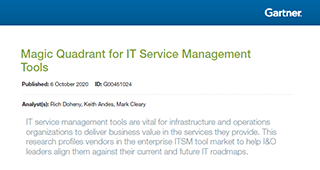Why is it that we remember certain quotes, for instance ones from Monty Python, popular movies, or (for us tech types), from British sitcoms like the IT Crowd? It’s because, in just a few short words, they convey a reality we all ruefully recognize. Unfortunately, though, when we’re walking around in the real IT world, the things we are more likely to hear are tag names, memes, and a few other tidbits that are so overused we fail to connect with the helpful advice they provide.
So, I thought it would be interesting to shake things up a bit. Rather than laying out a list of ITSM best practices, I’ll offer up a few quotes I find relevant to “service management” and share my thoughts on why they might be helpful. Perhaps you, too, will find they spur you to ask yourself about what messages you may not have been paying much attention to of late.
“There is a difference between knowing the path and walking the path.”
The Matrix movie 1999
I admit, I am a Matrix fan. Just imagine blithely living what you think is the truth and then suddenly discovering it is not what you thought! The whole Matrix concept of not knowing that you are part of a different reality is mind-bending, but you don’t have to look far to find similar narratives in our ITSM world. Just note the difference between the business vision/mission statements where you work and the results of ITSM customer surveys. How can their expectations and experiences be so far from what you think it should be?
The simple truth is, our customers’ reality is the path we’re meant to be walking and whether we use one or multiple frameworks to do it is irrelevant. What matters most is that we are using the frameworks as they were intended, to be adopted and adapted to our customers’ reality and their way of working, behaving, and being. And who knows? It may turn out that by working with them, we can model a better path to walk!
“Simplicity is the ultimate sophistication.”
Leonardo DaVinci
There has been much debate over the years about ‘to ITIL or not to ITIL…’ but, honestly? This ‘we’re doing ITIL’ phrase is bunkum! Service management is what we are doing and, we hope, we’re doing it as clearly and simply as possible in the unquestionably complicated world of ITSM. Customers want things to be easy and when they aren’t, they want and need clear and uncomplicated guidance. Our role in ITSM is to enable the organization with simple yet powerful solutions. Know the frameworks well so you can adapt what you need rather than trying to do it all. Sophisticated, elegant, and simple solutions are always a winner.
“Everybody says they want to be free. Take the train off the tracks and it’s free, but it can’t go anywhere.”
Zig Ziglar
Organizations require structure to operate, but most often end up creating silo towers with no connecting switch-track to communicate or change direction. Following a framework in exactness is limiting — but adapting a framework is not. There is no one-size-fits-all; that it’s a framework means you have the ability to lay the tracks any way you like. If, in the future, you decide to make an offshoot to a new destination, then you have the ability to do so with the guidance the framework provides.
ITSM is a continuous journey, not a project that ends on the ‘go live’ date. And if truth be known, there is no end to a project until all the chickens come home to roost (but that’s another blog). Count on this: There will always be other destinations to visit that will require you to lay tracks to get there.
“However beautiful the strategy, you should occasionally look at the results.”
Winston Churchill
We ITSM types tend to care a lot about what we measure, and don’t put much thought into what we don’t know how to measure (but need to know). Become wise about your reporting and metrics; design them so you can easily compare the results with the objectives and overall vision set by the organization. If your metrics can’t reveal the contribution to the ‘end game,’ then they won’t show you how to correct your path and get to the desired destination. You’ll succeed if you put your effort where it matters most, so know what you need to know and measure that!
“Urgency does not warrant changing methods that work for methods that do not work.”
Body of Lies movie (2008)
Being anxious about getting something done leads us to a dangerous trap; we often find ourselves changing up things that are already working just fine, when we would do better to focus on managing the relationship and expectations in the situation. As the saying goes, “If it ain’t broke, don’t fix it.”
However, if there is a real need for something to be changed, ensure you’re following good change management and continuous service improvement principles. Otherwise you might end up fixing one thing and breaking another.
“Highly skilled people can make up for inadequacies in the process, but no amount of process documentation can make up for people who are unwilling or unable to do their job.”
Larry Klosterboer, Implementing ITIL® Change and Release Management, 2009, IBM Press
“Try harder next time” is not a management method. It’s up to leadership to create an environment where people can succeed. Relationships matter; if you want to have influence, then you need to build good relationships. Building trust and competence in your people helps them to achieve what’s needed, including empowering them to do what’s necessary to fix inadequate process.
If your ITSM world were to end tomorrow, could you manage the chaos? More importantly, could you recover the status quo? It’s easy to get caught up in the outcome of a threat or risk and end up missing the whole point. The goal is to be realistic about its impact, which includes the people and skills you require both during and after such an event.
Leadership is essential in promoting the value of governance; that includes communicating how governance should be built into the process, rather than just being something we do as ‘check the box’ audits. RACI (Responsible, Accountable, Consulted, and Informed) matrices are the best way to ensure that responsibilities and accountabilities are defined, agreed on, and communicated by the roles involved.
Do You Have Memorable and Sustaining Quotes to Share?
Revisit the quotes and sayings you regularly use, and if you’re not getting the result you want, then perhaps it’s time to change what you’re saying.







